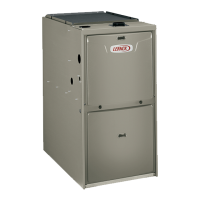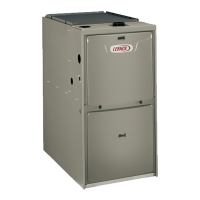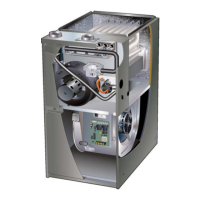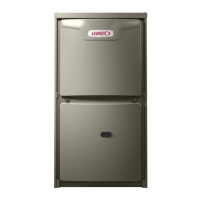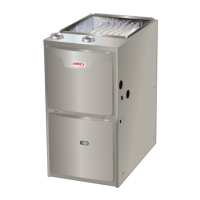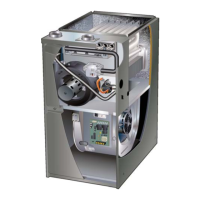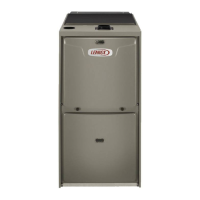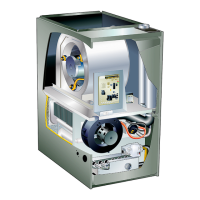Page 20
II-PLACEMENT AND INSTALLATION
Combustion, Dilution & Ventilation Air
If the ML195UH is installed as a Non-Direct Vent Fur
nace, follow the guidelines in this section.
NOTE - In Non-Direct Vent installations, combustion air is
taken from indoors and flue gases are discharged out-
doors.
In the past, there was no problem in bringing in sufficient
outdoor air for combustion. Infiltration provided all the air
that was needed. In today's homes, tight construction prac
tices make it necessary to bring in air from outside for com
bustion. Take into account that exhaust fans, appliance
vents, chimneys, and fireplaces force additional air that
could be used for combustion out of the house. Unless out
side air is brought into the house for combustion, negative
pressure (outside pressure is greater than inside pressure)
will build to the point that a downdraft can occur in the fur
nace vent pipe or chimney. As a result, combustion gases
enter the living space creating a potentially dangerous situ
ation.
In the absence of local codes concerning air for combus-
tion and ventilation, use the guidelines and procedures in
this section to install ML195UH furnaces to ensure efficient
and safe operation. You must consider combustion air
needs and requirements for exhaust vents and gas piping.
A portion of this information has been reprinted with per
mission from the National Fuel Gas Code (ANSI-
Z223.1/NFPA 54). This reprinted material is not the com
plete and official position of the ANSI on the referenced
subject, which is represented only by the standard in its en
tirety.
In Canada, refer to the CSA B149 installation codes.
CAUTION
Do not install the furnace in a corrosive or contami
nated atmosphere. Meet all combustion and ventila
tion air requirements, as well as all local codes.
All gas‐fired appliances require air for the combustion pro
cess. If sufficient combustion air is not available, the fur
nace or other appliance will operate inefficiently and un
safely. Enough air must be provided to meet the needs of
all fuel-burning appliances and appliances such as ex
haust fans which force air out of the house. When fire
places, exhaust fans, or clothes dryers are used at the
same time as the furnace, much more air is required to en
sure proper combustion and to prevent a downdraft. Insuf
ficient air causes incomplete combustion which can result
in carbon monoxide.
In addition to providing combustion air, fresh outdoor air di
lutes contaminants in the indoor air. These contaminants
may include bleaches, adhesives, detergents, solvents
and other contaminants which can corrode furnace compo
nents.
The requirements for providing air for combustion and ven
tilation depend largely on whether the furnace is installed in
an unconfined or a confined space.
Unconfined Space
An unconfined space is an area such as a basement or
large equipment room with a volume greater than 50 cubic
feet (1.42 m
3
) per 1,000 Btu (.29 kW) per hour of the com
bined input rating of all appliances installed in that space.
This space also includes adjacent rooms which are not
separated by a door. Though an area may appear to be un
confined, it might be necessary to bring in outdoor air for
combustion if the structure does not provide enough air by
infiltration. If the furnace is located in a building of tight
construction with weather stripping and caulking around
the windows and doors, follow the procedures in the Air
from Outside section.
Confined Space
A confined space is an area with a volume less than 50 cu
bic feet (1.42 m
3
) per 1,000 Btu (.29 kW) per hour of the
com-bined input rating of all appliances installed in that
space. This definition includes furnace closets or small
equipment rooms.
When the furnace is installed so that supply ducts carry air
circulated by the furnace to areas outside the space con
taining the furnace, the return air must be handled by ducts
which are sealed to the furnace casing and which terminate
outside the space containing the furnace. This is especially
important when the furnace is mounted on a platform in a
confined space such as a closet or small equipment room.
Even a small leak around the base of the unit at the platform
or at the return air duct connection can cause a potentially
dangerous negative pressure condition. Air for combustion
and ventilation can be brought into the confined space ei
ther from inside the building or from outside.
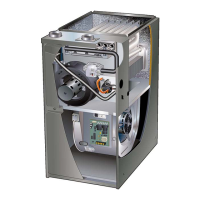
